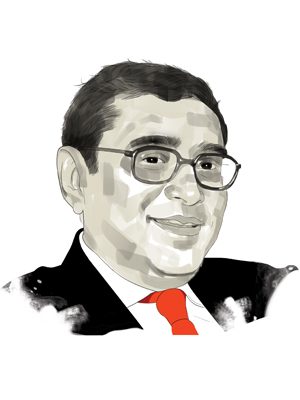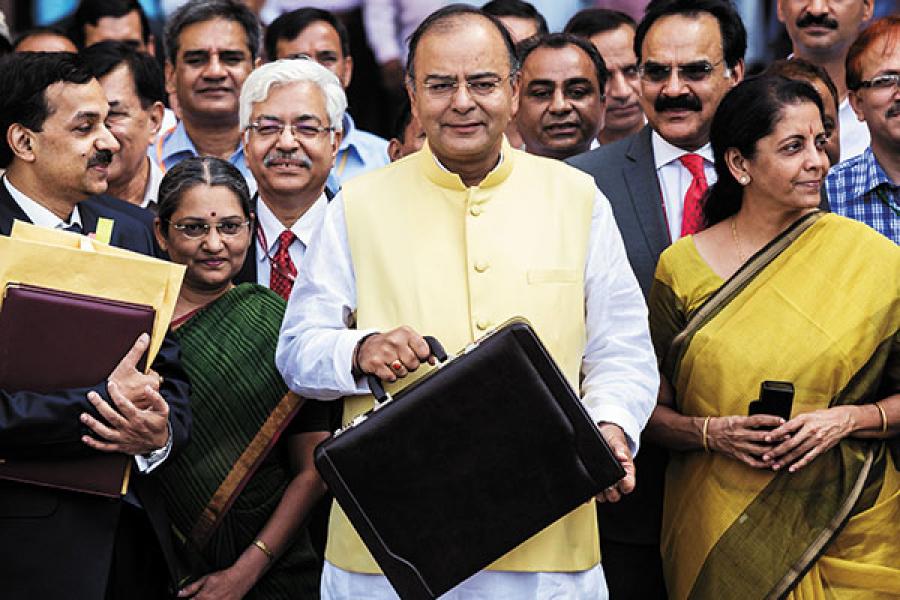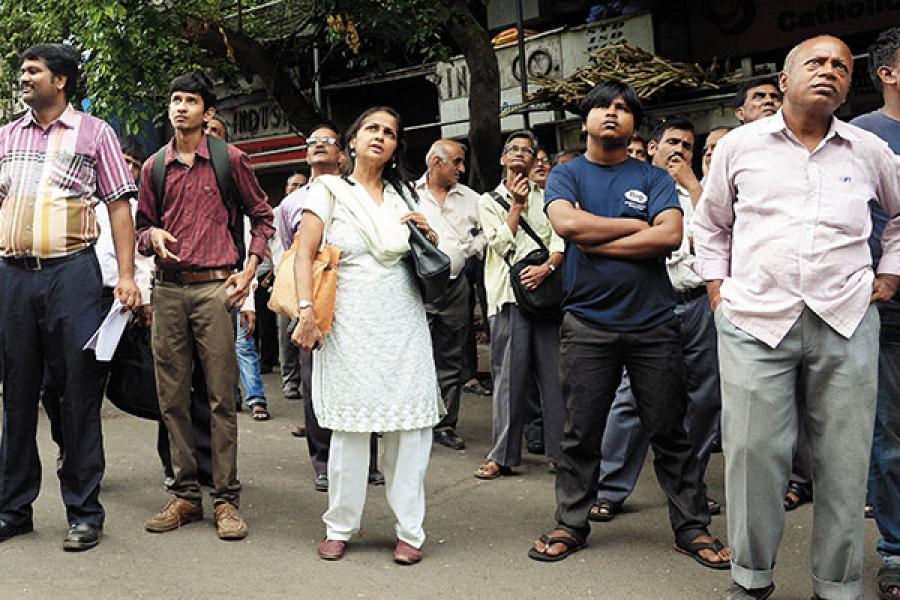
Is this really the first right-wing government?
It is a Right turn, but with a small 'R'
There is something monotonously ritualistic about an Indian Budget and the reactions to it. The Opposition invariably attacks it for being ‘anti-people’, ‘inflationary’ and lacking originality; the government side gushes over the schemes the finance minister has commended; and the ever-cautious captains of industry are character-istically mealy-mouthed in their responses, underplaying the negative aspects and gushing over the positives.
The 2014 Union Budget presented by Finance Minister Arun Jaitley after barely 45 days in office evoked the familiar template reactions. However, there was one thing that was dramatically different. There was a substantial section of what the minister described as “studio pundits” comprising economists, political analysts and general busybodies who expressed disappointment with the Budget for not being a radical departure from the past. They felt that the first Budget of the Narendra Modi government should have set the political markers for India’s enthusiastic embrace of what, in shorthand, is called right-wing politics.
That there would be a body of opinion supportive of the new dispensation that calls a government’s judgement into question on account of not being adequately ‘right’ is itself a novelty in a country that remains, as per the Constitution, a ‘socialist’ republic. This mood change demands an examination.
About four years or so ago, when the then Congress minister Salman Khurshid had been asked by a reporter why a particular Budget presented by the UPA government hadn’t addressed ‘reforms’, he replied (and I am quoting from memory): “We weren’t elected to bring in economic reforms.” Khurshid implied that since equity and redistribution were the Congress’s priorities, the party should not be judged for a failure to undertake what it was never really committed to.
By the same logic, Modi will be judged by the popular expectation of the big change he brings to India in the next five years. In ideological terms, he will also be measured by the extent to which he can dismantle the Nehruvian consensus in both economic policy and political thinking. To the community of the faithful that backed him enthusiastically for the top job in the face of liberal derision, Modi will not be examined by the lax standards reserved for the genial and over-consensual Atal Bihari Vajpayee. Purely in terms of expectations, Modi will be juxtaposed with the iconic figures of the modern Right: Margaret Thatcher, Lee Kuan Yew, et al. British PM David Cameron put it in perspective when he said that no other democratically-elected leader in today’s world has secured more votes than PM Modi. In the informal global community of the Right, the famous victory of May 2014 has already given Modi an exceptional status.
The challenge seems exceptionally daunting on account of the jumble of ideological baggage that Modi brings to the table. Conventional wisdom has identified the Right in developing countries with authoritarianism and anti-democratic sentiment. The military coup against the romantic but thoroughly incompetent Left-wing government of Salvador Allende in Chile was organised by a Right alliance of the military and multinational corporations. Likewise, the junta that ran Greece briefly, and the regimes of President Salazar in Portugal and General Franco in Spain have been clearly identified as ‘right-wing’.
Our contemporary understanding of Right and Left evolved during the Cold War and the identification of the US and Soviet Union with democracy and one-party rule respectively. Yet, this line of distinction was continuously blurred and modified by realpolitik. The US unendingly supported military dictatorships that were avowedly anti-Communist and the erstwhile Soviet Union rarely hesitated to support national liberation movements—both democratic and authoritarian—that had an anti-West tilt.
After the collapse of the Soviet Union and China’s experiment with Communist Party-directed capitalism, the Left-Right lines have been further blurred. The US and the European Union have selectively embraced the cause of human rights and the so-called civil society movements have developed associations with the intellectual, post-Leninist Left.
Where does Modi, and, for that matter, the BJP, fit into this new polarisation?
For a start, it is important to remember that the BJP has consciously shunned the ‘right’ label, preferring to be viewed in terms of its nationalist credentials. As a self-professed India First Party, the BJP has traditionally focussed its attacks on the ‘secular’ underpinnings of the Nehruvian consensus. Its most dramatic surge happened in the elections of 1989 and 1991 when it mounted a vigorous attack on ‘pseudo-secularism’ using the disputed shrine in Ayodhya as the symbol. Between 1991 and 1998, the BJP wallowed in its “majestic isolation” and devoted its energies towards creating a community of Hindus that would vote as Hindus.
The project was partially successful but to make that extra leap into power at the Centre, the BJP had to forge alliances with other non-Congress regional parties and this, in turn, led to a dilution of its larger Hindutva project. On paper, the BJP remains committed to Hindutva as a basis of nationhood. However, like socialism, a term prone to a multiplicity of definitions—some doctrinaire, others expedient—the importance of Hindutva in shaping the contours of practical politics has varied according to situations and individual inclinations. There was very little of explicit cultural nationalism in the elections of 2004 and 2009, both of which were lost by the party. On his part, throughout the 2014 election campaign, Modi took exceptional care to keep all identity politics out of his speeches. The promise of achhe din that won the BJP its most decisive national victory was entirely centred on jobs, opportunities, efficient government and better facilities for the citizen. There was nothing remotely metaphysical about the promised good times.
There was another dimension to the campaign: The hard selling of the Gujarat model of development. But whereas Modi’s detractors equated the Gujarat model with sectarian strife and the apparent neglect of the poor and marginalised communities, the BJP twinned the relative success of Gujarat in the growth league with the aspirations of Young India. Modi quite consciously conjured a national dream built on both personal and collective aspirations—the desire to make a mark in the fiercely competitive world. It was apparently clear from the aggressive campaign of Modi that the rapid economic growth of India was his one and only priority. It was also apparent that, unlike the UPA, he would not let doctrinaire consideration derail his project. He seemed to be echoing Deng Xiaoping’s famous saying about cats: “Black or white, as long as it catches mice.”
In political terms, this refusal to echo the socialist consensus, paint the government as the proverbial mai-baap sarkar and uphold a decrepit welfare system that had a massive in-built transmission loss, were significant departures. Not since the Swatantra Party of C Rajagopalachari bowed out of the political arena had any party campaigned on a plank that was so identifiably ‘right’. Modi may not be a Thatcher who was quite self-consciously a champion of free enterprise and free markets. He always projected his decisions as pragmatic rather than ideological choices. But since most of those choices were exercised in the context of Gujarat, it was apparent that Modi’s natural instincts were Right-of-Centre.
The new government’s Budget may have been shoddy in its presentation and was further hamstrung by its grim inheritance, a possible drought and rise in petroleum prices following a spate of renewed troubles in West Asia. However, despite the tentativeness, the indications of a shift in the strategic direction of the economy were visible.
The first was the establishment of the principle that—everything else being equal—the government must ensure that there is more money in the hands of individual taxpayers to spend on themselves and their families. To many, the lessening of the direct tax burden by the finance minister may seem unduly modest and barely in line with inflation and rising costs. However, the mere fact that it was announced despite huge pressures on the exchequer was meant to reinforce a political principle.
The second feature of the Budget was to shore up entrepreneurship in India. What distinguishes the Right (in all political parties) from those wedded to the Nehru-Indira consensus is the conviction that rapid economic growth will only come about through a spurt in entrepreneurship. By focusing on the reform and simplification of procedures—the details of which leave most of the middle classes mystified—the government is talking of the ease of doing business in India. Modi is among the few Indian politicians who genuinely believe that India is over-administered and under-governed. Finance Minister Arun Jaitley’s attention to business details was in line with the larger desire to create an environment conducive to entrepreneurship. In the coming months, we are likely to see the government move more rapidly in the direction of the rationalisation and simplification of India’s business laws.
The third, and consciously understated, feature of the Budget was the move away from the UPA’s bid to create a culture of welfare entitlements. Although there has been major budgetary cuts in Sonia Gandhi’s flagship schemes, such as the MGNREGA and the Right to Food programmes on account of a possible drought, the Modi government is slowly moving towards modifying some of these schemes. The creation of assets and skills are likely to feature as parallel objectives of programmes created for welfare handouts. This is certain to bring the government into direct conflict with the NGOs that were pampered and funded by the former government. But this conflict is perceived by the BJP as unavoidable and, in some cases, even welcome.
Finally, the Modi government wants to roll back the operational areas of the state. This is in line with the ‘minimum government’ principle enunciated by Modi during the campaign. The report of the Expenditure Management Commission will probably create the blueprint of the proposed retreat.
There was a belief in some quarters that the Modi government would pick up from where the Vajpayee government left and resume the audacious privatisation programme. However, this is one area where the move to an ideological principle of the Thatcherite Right has witnessed a U-turn. The Modi government seems to be extremely disinclined to transfer control and management of large and viable public sector units from the government to either the private sector or professional managers. This unwillingness stems from two factors. First, Modi is of the belief, based on his Gujarat experiences, that it is possible to dramatically improve the performance and profitability of PSUs by lessening political interference and giving managerial autonomy. What he wants is that there should be professional management but the government should be the majority stakeholder. Second, the BJP concluded during the post-mortem of its 2004 defeat that privatisation through strategic sales did not meet with popular endorsement and, in fact, made the government vulnerable to charges of cronyism.
Likewise, there is no doctrinaire commitment of the Modi dispensation in globalisation and free trade. There will be a definite opening-up of India to foreign capital and to overseas manufacturers. But this acknowledgement of the inevitability of globalisation will also be tempered by a larger desire to create a self-confident, indigenous capitalist class with a large footprint outside India. In its thinking, the BJP mirrors Indian capitalism’s profound wariness of gigantic corporations that lack a sense of rootedness.
In sum, there has been a marked rightward shift in the political centre of gravity after the election. However, the rash use of terms such as ‘Thatcherite’ and ‘neo-liberal’ may not suffice to describe the new phenomenon in India. Unlike the Left that is defined by a huge measure of universalism, the Right has traditionally lacked a doctrinal basis. The mental outlook of the Modi regime has been shaped by a blend of experience and political sense. That is why the contours of Right thinking are unlikely to stay rigid over the next five years. The ideological orientation of the Indian Right is forever a work in progress—as it is for the Right in any country.
(This story appears in the 22 August, 2014 issue of Forbes India. To visit our Archives, click here.)
-
 S.suchindranathaiyer
S.suchindranathaiyerPower and wealth hungry \"Political Man\" creates a paradigm and then spends a life time trying to make everything fit into it. \"Left\", \"Right\"? What is that? Like \"science\" or \"secularism\" preached by Governments that own, operate, loot, and mismanage temples as instruments of self serving \"social change\". \"The question is\", Said Alice, \"Whether you can make words mean so many things?\". \"The Question is\", Said the Walrus, \"Who is to be master than is all\"
on Aug 16, 2014 -
 Subha
SubhaThis article is a not making sense ...author should list out what modi should have done to have him a feeling that there is a positive change rather than simply beating around the bush......He expect miracles ??not even giving time for the government to settle down?? ..There are many positive decisions happened in the last few months which are visible to all impartial souls
on Aug 13, 2014

















